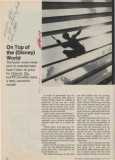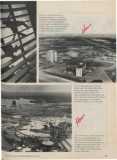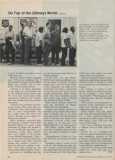The lavish never-never land of entertainment hasn't been all gravy for Orlando, Fla. but it's provided many a tasty economic morsel
A couple of generations ago, Orlando was a pleasant little place in central Florida noted for nothing in particular. It was not on a main highway nor on the main line of the railroad. Sunny beaches were a long way off. The area was good for citrus-growing, but not much else.
Thirty miles north was Sanford – on the main highway, on the railroad main line, on a major river. Sanford seemingly was a coming metropolis. Orlando could look to a modest future.
Things didn't work that way. Orlando's business and civic leaders got fire in their blood years ago and it was their town that grew to dominate the area. And now Orlando has taken in stride Disney World — mankind's biggest, most-lavish never-never land of entertainment.
Disney World, less than a year and a half old, has affected Orlando, no doubt about that. And much of the rest of Florida, too.
The initial investment in the park was $400 million and it's growing. Eleven thousand year-round jobs have been created and the park, which included 26,000 acres, has sent land values soaring from four to 20 times in a radius of 50 miles. Traffic patterns in the area have been altered, and new roads have been built. School and health facility capacities have doubled.
Satellite businesses have been created and old ones have grown so much they are hardly recognizable. A man named Champ Williams, for example, saw his restaurant and air-line-catering business double in 10 months last year. The First National Bank of Orlando, banker for the Disney account, established a countinghouse which handles 2 1/2 tons of coins daily.
Not everyone in Orlando has been happy about Disney World. From the time plans for it were first announced, in 1966, until recently there was a critical chorus: The city can't survive Disney World; we don't want to grow, we didn't move here to have traffic jams, etc.
[img]Under the bright Florida sun, buildings spring up — including housing for residents and tourists and work space for businesses. Construction materials were scarce, briefly. There was some opposition to the growth but it began dying as extra tax money poured in.[/img]
[img]Swampland and acres of scrub timber near the Disney World site, where once only rattlesnakes thrived, have been filling with huge developments. Among the first under way was Florida Center (shown at an early stage). It's a project of Major Realty Corp. and Gulf Oil.[/img]
[img]You can take your choice at Disney World — use a hotel inside the grounds of the 26,000-acre park such as the one in the background, or stay in one of the fancy new motels outside the gates. The prize range is from inexpensive to very expensive.[/img]
[img]The Salvation Army in Orlando has been inundated by job-seekers who needed help — there were 18,000 of them in one nine-month period. "But now," says the Army's Brigadier Richard T. Bergren, "the number of people coming in has slackened considerably."[/img]
However, Mayor Carl T. Langford says: "We've got problems, but I don't know of a mayor in the United States who wouldn't like to have Disney World outside his door.
"Orlando is no longer dependent on the whims of a few factories, nor on the weather and the citrus crop. We never had much tourism trade compared to Miami or Ft. Lauderdale; now we have one of the greatest attractions.
"Tourists come to Disney World in family groups. They want clean entertainment. They don't create crime and we aren't crime infested. We have traffic jams, but what town doesn't? Besides, we are stendily reducing that problem."
Major problems connected with the opening of Disney World have included helping the needy among thousands of people who flocked to the area to find jobs and didn't, and combating a drug abuse problem. Says Larry Rubin of the Orange County Health Department: "There's no question that Disney World, being a fantasy trip itself, attracted people who wanted a fantasy — a drug trip. But we're making it now; we're more than gaining on the pushers from Miami and New York."
And there is a squabble over who is to pay paving roads that lead to Disney property.
A big worry was how Disney World would affect established tourist attractions in Florida. Would it cripple them? Just the reverse seems to have happened. Air traffic at Ft. Lauderdale and Tampa, respectively on the east and west coasts, has increased dramatically. Beach reports miles away have benefited greatly from visitors who came to Florida, only because of Disney World.
Some feared Orlando would come too dependent on Disney World. This was groundless.
Orlando was already thriving as the home of the largest citrus operations in Florida and as its area's main distribution and transportation center. It sported a new branch of the University of Florida, a Navy training station, an air base and a big Martin-Marietta Corp. defense plant.
But Disney World, which drew more than 10 million visitors its first year, has helped Orlando in many ways.
Unemployment is down to 3 per cent and sales tax returns are zooming.
Occupancy rates in motels run 86 to 90 per cent during the peak season — summer. A year ago there were less than 6,000 motel or hotel rooms in the Orlando area. Now, more than 30,000 have been added, are under construction or are planned.
With an expected Orlando metropolitan area population increase from 428,000 in 1970 to 561,000 by 1975, every business has an opportunity to prosper.
For example, a number of non-Disney tourist attractions have started up, including a "Sea World," "Dog World," "Wild Kingdom," and a Ringling Bros. Barnum & Bailey Circus park.
What could be of even greater importance is the construction of new towns near Orlando and vast developments inside the city.
Major Realty Corp. has joined with Gulf Oil to build Florida Center, a posh residential-industrial-commercial complex which will cost $600 million, cover 2,700 acres and house 45,000 people.
GAC Corp. is building Poinciana, a separate town 21 miles from Orlando.
Florida Gas Co. is building the 2,250-acre North Orlando living area, and completing planning on the 4,500-acre Orangewood development near Disney World. Forty-eight thousand people live in Orangewood in nine different neighborhoods.
Not bad for a pleasant little place which once could only look to a modest future.


